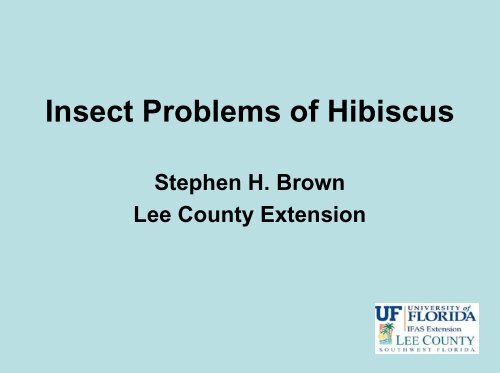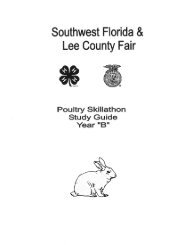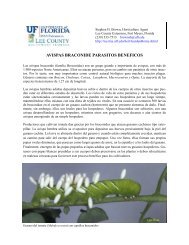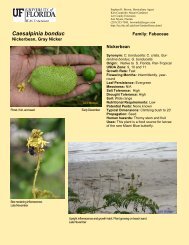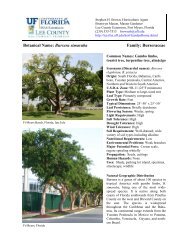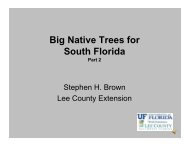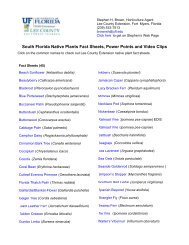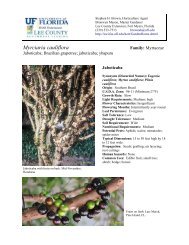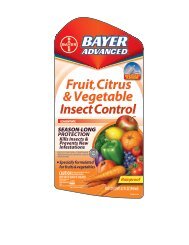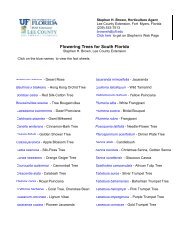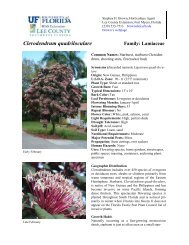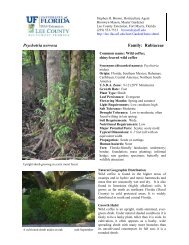Insect Problems of Hibiscus - Lee County Extension
Insect Problems of Hibiscus - Lee County Extension
Insect Problems of Hibiscus - Lee County Extension
Create successful ePaper yourself
Turn your PDF publications into a flip-book with our unique Google optimized e-Paper software.
<strong>Insect</strong> <strong>Problems</strong> <strong>of</strong> <strong>Hibiscus</strong><br />
Stephen H. Brown<br />
<strong>Lee</strong> <strong>County</strong> <strong>Extension</strong>
<strong>Hibiscus</strong> rosa-sinensis<br />
Chi Chinese <strong>Hibiscus</strong> Hibi<br />
• Origin: China<br />
• GGrowth h Rate: R FFast<br />
• Salt tolerance: Medium<br />
• Drought Tolerance: Low<br />
• Nutritional Requirements: High<br />
• Human Hazard: Mostly inert but<br />
a few people have reported skin<br />
irritation<br />
• Fl Flowering i season: YYear-roundd • Additional Notes: Hundreds <strong>of</strong><br />
cultivars exist.
<strong>Insect</strong> and Mite feedings represent the<br />
majority j y <strong>of</strong> pproblems for hibiscus pplants.
What are Aphids?<br />
•S<strong>of</strong>t-bodied, pear-shaped<br />
iinsects t<br />
• CColors l iinclude l d bbrown, bl black, k yellow, ll pink i k or bl blue<br />
• Two short cornicles at the rear <strong>of</strong> the body<br />
• FFound d in i clusters l t or colonies l i<br />
• Commonly found on young developing tissue<br />
• Feeding causes new leaf distortion<br />
• Ability to transmit plant viral disease
Aphids<br />
Aphids accumulate on new leaves and on emerging flower buds<br />
Aphids accumulate on new leaves and on emerging flower buds.<br />
Often the first indication <strong>of</strong> an aphid, scale, mealybug, or whitefly<br />
problem is the presence <strong>of</strong> ants.
Distorted leaves on new foliage caused by feeding aphids
What to Do<br />
• Natural enemies including ladybeetles, syrphid fly larvae,<br />
parasitic p wasps p<br />
• One can possibly dislodge aphids with high pressure<br />
water sprays from the garden hose hose.<br />
• Avoid over fertilization that stimulates excessive new<br />
growth.<br />
• Use insecticidal soaps or horticultural oils<br />
• Other insecticides available
What are Mealybugs?<br />
• S<strong>of</strong>t-bodied insects covered with a fine, white,<br />
powdery or cottony wax wax-like like material material, sometimes<br />
extending from the side <strong>of</strong> the body as waxy<br />
filaments filaments.<br />
• They have piercing-sucking mouthparts.<br />
• Damage appears as chlorotic spots on leaves leaves.<br />
• The life cycle takes about 30 days at 80°F.
Mealybug damaged hibiscus in foreground. All kinds <strong>of</strong> mealybugs<br />
infest hibiscus plants.
Solenopsis mealybugs<br />
(Phenacoccus ( solenopsis) p )<br />
An unhealthy hibiscus<br />
plant needs closer<br />
examination to determine<br />
its problems.<br />
The following slide is the result<br />
<strong>of</strong> closer inspection. p
Solenopsis mealybugs infestation<br />
Close up <strong>of</strong> solenopsis mealybugs<br />
A large mealybug commonly found on hibiscus in Florida
Striped Mealybug (Ferrisia virgata )<br />
Another sickly hibiscus has scant<br />
leaves, sooty mold, and tip<br />
di dieback. b k Th The following f ll i two t slides lid<br />
are upon closer inspection.
Striped Mealybug<br />
Striped mealybugs, Ferrisia virgata, on the underside <strong>of</strong> leaf. This is<br />
the same leaf as on the previous slide.
Close up <strong>of</strong> striped mealybugs, Ferrisia virgata, and the copious<br />
amount <strong>of</strong> wax they produce.
Papaya Mealybug (Paracoccus marginatus)<br />
Adult and egg sacks <strong>of</strong><br />
papaya mealybug.<br />
Source Pub. EENY302, UF IFAS<br />
Papaya mealybugs and aphids<br />
on hibiscus flower bud bud.<br />
•The papaya mealybug was first discovered in Manatee and Palm<br />
Beach Counties in 1998.<br />
•Native to Mexico and/or Central America<br />
•Typically as clusters <strong>of</strong> cotton-like masses<br />
•Biological control identified as a key management strategy
Papaya mealybugs cause early leaf<br />
drop and can kill hibiscus plants.<br />
Papaya Mealybug<br />
A heavy infestation on the<br />
stem <strong>of</strong> the plant on the left.
What to Do<br />
• Inspect plants before purchase or installation<br />
• Increase air flow or decrease plant density<br />
• Ladybird beetles beetles, green lacewings lacewings, and tiny wasps <strong>of</strong>ten<br />
suppress populations. These insects are naturally<br />
present in the environment.<br />
• Try to use horticultural oils rather than broad spectrum<br />
iinsecticides ti id which hi h kill <strong>of</strong>f ff valuable l bl natural t l enemies<br />
i
What to Do<br />
• Horticultural oils kills all stages <strong>of</strong> scales that are present<br />
at time <strong>of</strong> application. application Contact with the pest and excellent<br />
coverage is necessary to control the pest.<br />
• Repeated applications may be necessary<br />
• Potential phytotoxicity under high temperatures can<br />
occur with the use <strong>of</strong> oils<br />
• A systemic insecticide may give several months <strong>of</strong><br />
control
What to Do<br />
Ladybird larvae Lacewing eggs<br />
•Ladybird beetles, green lacewings, and tiny wasps<br />
<strong>of</strong>ten suppress populations
Pink <strong>Hibiscus</strong> Mealybug (PHM)<br />
(M (Maconellicoccus lli hirsutus) hi t )<br />
Damage caused by PHM
Pink <strong>Hibiscus</strong> Mealybug<br />
• First detected in Miami-Dade Miami Dade Counties in 2002<br />
• PHM attacks more than 125 plant species<br />
• Spread by wind, wind ants, ants stuck on clothing, clothing on the<br />
hairs <strong>of</strong> animals, or the movement <strong>of</strong> infested<br />
plants p<br />
• A life cycle <strong>of</strong> 24 to 30 days<br />
• Feeds eeds by suc sucking g sap from o pplant a t
PHM damage is caused by feeding on the plant sap and releasing<br />
toxic substances. Crinkled or twisted leaves and shoots are<br />
recognizable symptoms.
Pink <strong>Hibiscus</strong> Mealybug
Pink <strong>Hibiscus</strong> Mealybug<br />
Maconellicoccus hirsutus damage to hedge
Pink hibiscus mealybugs adult females<br />
Pink hibiscus mealybug<br />
adult male<br />
Source: FDACS, Jeffrey W. Lotz Source: USDA Agricultural Research Service
Maconellicoccus hirsutus infestation<br />
Pink <strong>Hibiscus</strong> Mealybug<br />
The female mealybug produces more than<br />
10 generations per year in colonies <strong>of</strong> 500<br />
eggs or more.<br />
Chemical control by y contact insecticide<br />
is difficult because the waxy covering<br />
protects the mealybugs and their eggs.
Pink <strong>Hibiscus</strong> Mealybug<br />
Toxic saliva causes leaf curling and<br />
shortened internodes termed<br />
‘Bunchy top.’<br />
Should you prune?
Pink <strong>Hibiscus</strong> Mealybug<br />
Do NOT cut or trim the plants you think have PHM! PHM spreads most<br />
easily by the wind and the movement <strong>of</strong> infested plants.
What to do: Homeowners<br />
• DPI has released mealybug destroyers and 2 parasitic wasp<br />
species. The former is quite effective against PHM.<br />
• Do not clip p infested pplants to show anyone. y<br />
• Avoid spraying foliage as that will kill the beneficial insects.<br />
• Foliar applications <strong>of</strong> insecticidal soaps and oils are less harmful to<br />
natural enemies.<br />
• Use a systemic root drench such as Imidacloprid (Bayer’s Advanced<br />
Tree and Shrub <strong>Insect</strong> Control) for best control<br />
• Branches may need to be pruned following the root drench<br />
treatment to induce new growth.<br />
• Click here for more on the control <strong>of</strong> scales and mealybugs on<br />
ornamentals
What to do: Pr<strong>of</strong>essional and Growers<br />
• DPI has released mealybug destroyers and 2 parasitic<br />
wasp species. The former is quite effective against PHM.<br />
• Do not clip infested plants to show anyone.<br />
• Avoid spraying foliage as that will kill the beneficial<br />
insects.<br />
• Foliar applications <strong>of</strong> insecticidal soaps and oils are less<br />
harmful to natural enemies.
What to do: Pr<strong>of</strong>essional and Growers<br />
• Otherwise, apply foliar applications <strong>of</strong> bifenthrin (i.e. Talstar),<br />
acephate (i.e. Orthene), chlorpyrifos (i.e. DuraGuard ME),<br />
neonicotinoids (i.e. Flagship, Marathon, Safari, TriStar) and others<br />
• Or a systemic root drench such as Imidacloprid (i.e. Merit or Bayer’s<br />
Advanced Tree and Shrub <strong>Insect</strong> Control) for longest control. A<br />
systemic t i root t drench d h <strong>of</strong>ten ft negates t the th use <strong>of</strong> f a ffoliar li applied li d<br />
insecticide<br />
• Branches may need to be pruned following the root drench<br />
treatment to induce new growth.<br />
• Click here for more on the control <strong>of</strong> scale insects and mealybugs on<br />
• Click here for more on the control <strong>of</strong> scale insects and mealybugs on<br />
ornamental plants.
What are Scales?<br />
•They are divided into 2<br />
groups; g armored and s<strong>of</strong>t<br />
scales<br />
• They feed by sucking sap from plants<br />
• They y feed on leaves, , stems and trunks<br />
• Spread in crawler stage by man, birds, other<br />
animals and wind currents<br />
• If not controlled can cause leaf drop, dead twigs<br />
and branches.
Lesser Snow Scales (Pinnaspis strachani)<br />
Mature scales on stem<br />
This is an armored scale. The first stage after<br />
hatching is the only nymphal stage with legs, so<br />
the insects are called crawlers. Crawlers may<br />
stay under the maternal armor several hours<br />
until outside conditions, especially temperature<br />
and humidity, are good.
It requires an observant eye to detect grenade scales on hibiscus<br />
stem.
Lobate Lac Scales<br />
(Paratachardina ( pseudolobata)<br />
p )<br />
Lobate lac scales and grenade scales on hibiscus stem.
What to do<br />
• If contact insecticide is used, timing g to kill the crawler<br />
stage is critical since applications made too late may not<br />
control scales, because <strong>of</strong> their waxy covering, and may<br />
interfere with natural enemies, aggravating gg g the pproblem.<br />
• Horticultural oils control s<strong>of</strong>t scales during most <strong>of</strong> their<br />
lives and control hard scales only shortly after egg hatch<br />
when their covering is relatively thin<br />
• Horticultural soap will control s<strong>of</strong>t scales but not<br />
recommended for the control <strong>of</strong> armored scales
What to do<br />
For the control <strong>of</strong> both s<strong>of</strong>t and armored scales:<br />
• Neonicotinoides including those with active ingredients Acetamiprid,<br />
Dinotefuran and Imidacloprid (Merit, Bayer Advanced GardenTree<br />
and Shrub <strong>Insect</strong> Control)<br />
• Acephate; Azadirachtin; Bifenthrin (talstar), Cyfulthrin (Bayer<br />
Advanced Garden Power Force Multi-<strong>Insect</strong> Killer); Dysulfoton<br />
(Bayer Advanced Garden 2-in-1 systemic Azalea, Camellia &<br />
Rhododendron Care); Malathion; Pyhomatoxin; Pyrethroid;<br />
Pyriproxyfen<br />
• Click here for more on scales and mealybugs
• They are very small and slender<br />
What are Thrips?<br />
• They have rasping-sucking mouthparts to withdraw plant<br />
juices.<br />
• Thrips populations peak during the spring and fall<br />
months<br />
• The They damage both foliage and flo flowers ers<br />
• Life cycle (egg to adult) takes 2 to 4 weeks, with 3<br />
generations g pper yyear
Haplothrips sp. (Haplohrips)<br />
Damage caused by haplothrips
Haplothrips<br />
Haplothrips sp. nymphs Haplothrips sp. adult<br />
Several species feed on a variety <strong>of</strong> plants.
Liothrips varicornis (Liothrips)<br />
Liothrips damage includes chlorotic and dead leaves.
Liothrips<br />
Piratebug, Montandoniola moraguesi,<br />
preys on thrips.<br />
Severe damage includes pitted<br />
stems and leaf petioles p that<br />
probably induce chlorotic leaves.
Liothrips p<br />
varicornis larvae and adult
Liothrips larvae on hibiscus stem
What to do<br />
• Several arthropods help keep thrips populations under control,<br />
including green lacewing larvae, ladybird beetles, parasitic wasps,<br />
other predaceous thrips, and predatory mites.<br />
• Soaps are safe and effective in controlling thrips thrips.<br />
• Many insecticides are available for the control <strong>of</strong> thrips. Table 1.<br />
• Several systemic insecticides can be applied as soil drenches, so<br />
that the roots take up the toxicant and spread it to where the insects<br />
are ffeeding.<br />
They may achieve control within several weeks, but are<br />
effective for a longer time than most contact insecticides.
www.natureinmypocket.com<br />
Myllocerus undatus<br />
(Sri Lanka Weevil)<br />
• The life cycle <strong>of</strong> this weevil under laboratory conditions is<br />
less than 2 months.<br />
• Adults lay their eggs in the soil soil.<br />
• Larvae are small, creamy white, and legless. They are<br />
root feeders.<br />
• Adults can cause severe feeding damage to the foliage.<br />
Damage can range from notching on the leaf margins to<br />
a much more extensive feeding along the leaf veins veins.
Myllocerus undatus
• Difficult to control<br />
What to do<br />
• Older, larger plants can tolerate the feeding damage<br />
• Severe infestations can possibly be controlled by using<br />
the active ingredient Cyhalothrin contained in Triazicide.<br />
Sevin (Carbaryl), ( y), Bifenthrin (Talstar) ( ) and Acephate p<br />
(Orthene) are also recommended<br />
• <strong>Insect</strong>icides used for leaf feeding insects will work, but<br />
most do not last very long as more weevils return so<br />
repeat p applications pp are necessary y
What are Midges?<br />
• Gnat-like flies<br />
• Three huge g ggroups; biting, g non-biting, g ggall
Contarinia maculipennsis<br />
(<strong>Hibiscus</strong> Bud Midge)<br />
• A small fly that lays its<br />
eggs in flower buds<br />
including hibiscus and<br />
DDendrobium d bi orchids. hid<br />
• When the egg hatch hatch, tiny<br />
worm-like larvae emerge<br />
that damage young bud,<br />
causing i it tto fall f ll tto the th<br />
ground.
Larva that has just existed the<br />
infested bud to pupate in the<br />
soil<br />
<strong>Hibiscus</strong> Bud Midge<br />
• Able to jump or spring several<br />
centimeters<br />
• Once larvae are fully<br />
developed they drop to the<br />
soil where they eventually<br />
burrow into the soil and<br />
pupate
cut into <strong>of</strong>f-color buds and buds that<br />
have dropped prematurely to check<br />
for little <strong>of</strong>f <strong>of</strong>f-white white midge maggots maggots.<br />
<strong>Hibiscus</strong> Bud Midge<br />
<strong>Hibiscus</strong> bud midge maggots feed inside unopened flower buds<br />
causing deformed, discolored buds and blossoms, and in<br />
severe infestations, premature bud or blossom drop.
What to do<br />
• Remove all dropped buds or buds on the plant that are<br />
beginning to molt molt.<br />
• Because the larvae enter the soil to pupate, p p ppesticide<br />
applications that kill insects in the soil could be useful.<br />
• SSeveral l systemic t i iinsecticides ti id such h as IImidacloprid id l id can bbe<br />
applied as soil drenches, so that the roots take up the<br />
toxicant and spread p it to where the insects are feeding. g<br />
They may achieve control within several weeks, but are<br />
effective for a longer time than most contact insecticides.
Other Causes <strong>of</strong> Bud Drop<br />
• Thrips<br />
• Caterpillars<br />
• NNematodes t d<br />
• Nutritional deficiencies<br />
• Overfertilization<br />
• Environmental factors such as poor<br />
drainage, excessive water, drought, salt<br />
spray
Key Diseases <strong>of</strong> <strong>Hibiscus</strong><br />
• Anthracnose (Colletotrichum spp.)<br />
• BBacterial t i l spots t (Pseudomonas, (P d XXanthomonas th<br />
spp.)<br />
• Bl Blossom blight bli ht (Ch (Choanephora h spp.) )<br />
• Leaf spots (Pseudocercospora sp.)<br />
• RRoot t and d stem t rots t (Phytophthora, (Ph t hth Pthi Pythium spp.;<br />
Rhizoctonia solani)<br />
• RRust t (K (Kuehneola, h l PPuccinia i i spp.)<br />
)
Key Nematode<br />
• Root-knot Root knot nematodes (Meloidogyne spp spp.)<br />
)
What’s that black discoloration here the leaf base meets the petiole?<br />
What’s that black discoloration where the leaf base meets the petiole?<br />
When severe it seems to cause premature leaf drop.
• If you know, k let l t me know. k<br />
• Negative for disease and insects.
Slides from the collections <strong>of</strong><br />
• Stephen Brown, <strong>Lee</strong> <strong>County</strong> <strong>Extension</strong><br />
• Lyle Buss, <strong>Insect</strong> Identification Laboratory, UF<br />
• Doug Caldwell, Collier <strong>County</strong> <strong>Extension</strong><br />
• And where indicated under such slides<br />
Brown’s e-mail address: brownsh@ufl.edu<br />
Brown’s Web Page
Other Power points on <strong>Insect</strong> <strong>Problems</strong>:<br />
Croton Scales<br />
Erythrina Gall Wasp<br />
Slash Pine Scales


